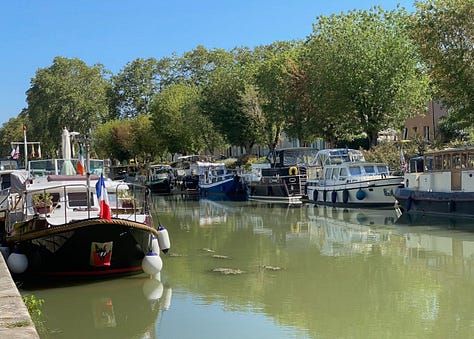Moissac? Whazzat?
Travellers are understandably attracted to the well-known spots—Paris, Rome, London—but getting out to the countryside gets you closer to the people and the land

For such a small town (pop. 13,000), there was a surprisingly large amount to learn about Moissac after I took the train there from Toulouse last fall. The only reason I’d even heard of it was because a friend and former colleague from the Montreal Gazette newspaper now lives there part of the year with her French husband.
Even my new acquaintances in Toulouse scratched their heads when I mentioned Moissac. C’est où, ça? But anyone who has done the Puy-en-Velay leg of The Way of St. James pilgrimage—also known as Camino de Santiago—will no doubt know Moissac as the charming town that hosts tens of thousands of pilgrims every year who visit the ancient St. Pierre Abbey.









Moissac is just one of 30 stops on the 750-km Puy-en-Velay route from the Upper Loire to the Pays Basque. And Puy-en-Velay is just one of five main routes (or “Ways”) you can take through France to connect to St. Jean Pied de Port. That’s where the official Camino Francès begins, winding a further 800 km through Spain to the town of Santiago de Compostela. Of course, many hikers take shorter Camino routes, but the advantage of any of the Ways is that food and accommodations have been established over many years to meet the needs of pilgrims.
Although the linch pins for the various routes are the religious sites along the way, you don’t need to be a believer to “follow the path,” just in reasonably good shape and ready to accept less-than-luxurious accommodations at some spots.
It’s a great way to see the country (France, Portugal or Spain) from the perspective of the people who are the backbone of the rural and agricultural economy. And to see nature up close rather than speeding past it at 100 km an hour.
For one man’s perspective on what it’s like to walk the Camino, let me introduce you to Ebbe Munk, a fellow wanderer of Danish extraction whom I met on the ferry between Nador, Morocco, and Sètes, France, in January. Ebbe walked the entire Francès route and shares his thoughts, advice and lots of photos on his blog.
For more info, here’s a place to start for the entire Camino, or try this for just the routes in France. These first is a commercial website, but has extensive information that’s free to peruse and help you plan.
⚜ ⚜ ⚜
Anyway, I have wandered way off the path myself with this Camino segue.
So, back to Moissac. I wrote about it quite extensively back in September so won’t re-hash what you’ll find in that enlightening column. I haven’t returned since, but my Gazette friend, Charlie Fidelman, will be back from Mexico soon to finish setting up the second edition of the Art d’Oc Pictures festival that she launched in Moissac last year.
If you’re anywhere in France’s Occitanie region this September, you’ll want to check out this year’s exhibition of photos from various professionals on the theme of Fragile Beauty, photographic art that connects nature, ecology, biodiversity and and humanity.
The 2024 edition will highlight the work of Olivier Grunewald and Bernadette Gilbertas, whose Origins exhibition features photos taken over 30 years of exploring the hidden corners of the planet and helps trace the path of its evolution.
And if you’re not in the mood to walk to Moissac along the Camino, the Occitanie region has initiated a prize-winning Rail Tour package that offers 19 different itineraries that gives you unlimited travel for €10 a day for up to six consecutive days to Moissac and towns like Lourdes, Narbonne, Perpignan, Montpellier, Nîmes and, of course, Toulouse. The region is about the size of Ireland, so rail is a glorious way to explore it without the distraction of driving yourself.
Damn, writing this column has triggered my travel bug again, so I’ll let you go for today and start figuring out where I’m off to next. I saw a rail trip to the Pyrenees Mountains on the Occitanie Tourism site, is that my next adventure? Who knows? Stay tuned, and thanks for sticking around for the ride.






I always say the same thing about Italy. Most people focus on the starter pack (Rome-Florence-Venice), but the real good stuff happens in the smaller towns, where there is no felt need to make everything polished for tourists. You just get to exist with other people in their communities ♥️
Nice! What is the weather like over there these days?